Revisiting Weingut Bernhard Huber
Posted on December 29, 2025
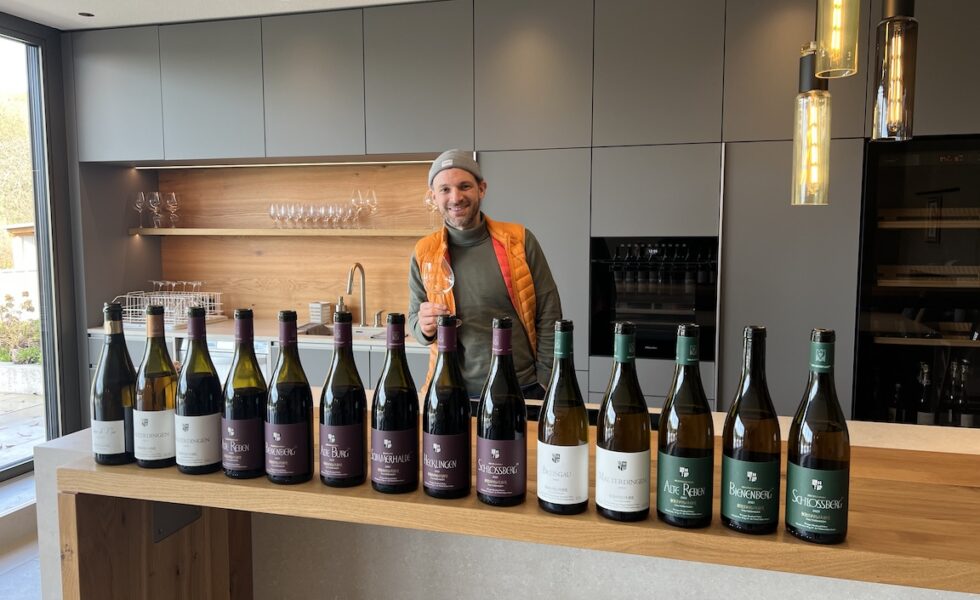
Malterdingen, Baden-Württemberg: Burgundy Precision, Baden Soul
By Panos Kakaviatos for Wine Chronicles
29 December 2025
A visit to Weingut Bernhard Huber in Malterdingen is never just a tasting; it is a lesson in continuity, restraint, and conviction. I visited the estate on 11 November, in the calm that follows harvest – and a bank holiday in France. Julian Huber was not present that day, but a highly accomplished sommelier from the estate welcomed a friend and me, guiding us through an impressively broad and revealing lineup.
Few German wineries have shaped the modern understanding of Pinot Noir and Chardonnay as profoundly as Huber. Bernhard Huber was among the first to demonstrate that Germany could produce Pinot Noirs of genuine gravitas and longevity, not by chasing ripeness, but by embracing structure, restraint, and terroir. Bernhard’s frequent exchanges with Burgundy and his refusal to follow trends allowed him, already in the early 1990s, to craft wines that stood apart at a time when many sought power over precision.
When Julian Huber took over in 2014, aged just 24, expectations were daunting. A decade later, it is clear that he has not merely preserved his father’s legacy but sharpened it. Burgundy remains a reference point, but the wines today speak more clearly of Malterdingen, Bienenberg, Sommerhalde or Schlossberg than of any external model. The stylistic evolution is subtle but decisive: less overt oak, cooler fruit profiles, more reduction, and a striking sense of tension and salinity across both reds and whites.
The estate now harvests around 35 hectares, predominantly in Pinot Noir, rooted in weathered shell limestone soils that echo the Côte d’Or in their ability to confer finesse and longevity. Vineyard work is paramount, yields are modest, and sélection massale is used to refine the finest parcels. Grape variety has largely disappeared from labels: here, place matters more than nomenclature.
In the Glass: A Tasting Snapshot (11 November)
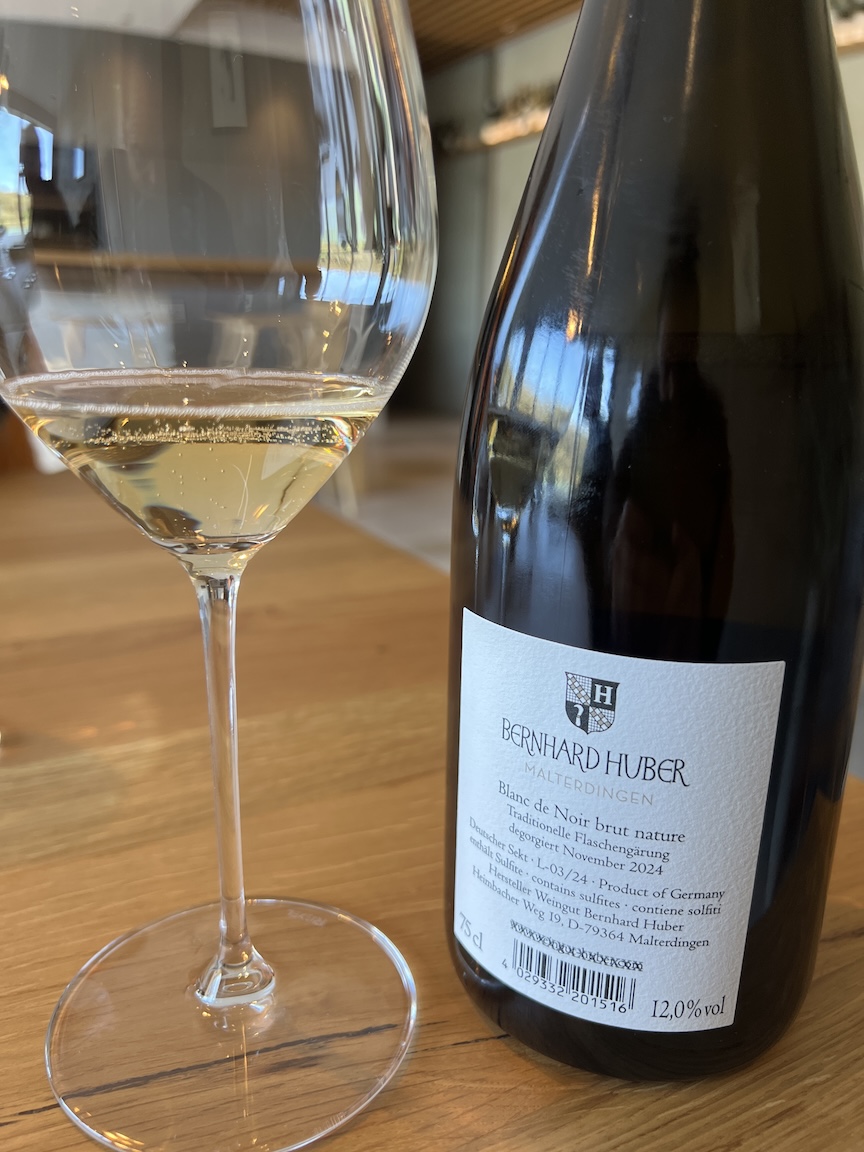
Excellent, traditional method bubbly
The tasting opened with their traditional method bubbly Blanc de Noirs, creamy yet precise, offering quiet depth rather than overt fruit. The dry rosé, produced since 2020 but pointedly without the word “rosé” on the label, underlined Huber’s philosophy: this is a terroir wine, smoky, reductive, and structured, aged 14 months in barrel with one-third new oak: decidedly not a casual summer pour.
We tasted through wines from the 2023 vintage, which, we learned, was warm and healthy overall, but punctuated by rain just before and during harvest. Larger berries and thinner skins brought mildew concerns, yet the finished wines show admirable clarity and balance rather than dilution.
Among the Pinots, the Malterdingen Ortswein (white label, red capsule) offered a classic, poised expression: fine red fruit, moderate alcohol (13%), and impressive depth for vines averaging 25 years. The step up to Alte Reben (red label) was immediate: older vines (around 45 years), lower yields, greater textural depth, spice, and tannic presence, still framed by Malterdingen’s signature finesse. Oak remains measured at one-third new, notably less than under Bernhard. The estate boasts many great growths, the equivalent of grands crus, designated in German as Grosses Gewächs or GG.

Whether a premier cru or GG level, distinctions sharpened. And I love the graphic design sense of the estate: white labels designate regions, while the red labels designate more premium level wines at village, premier cru or GG grand cru. Same for the whites, only labels for premium level wines are green.
-
The Bienenberg GG was beguiling yet reserved, with more acidity, limestone-driven structure, and a flirtatious nose that belied a tightly wound palate demanding cellar time.
-
The Köndringen, from younger Pinot Noir vines planted in 2018, was muscular and wind-swept, with spice, firm tannins, and a touch of bitterness.
-
The Sommerhalde GG on red clay and limestone near the Black Forest at 350 metres in elevation showed wonderful balance and poise, though extraction here requires a careful hand.
-
The Hecklingen, tasted from its very first vintage in 2023, felt frank but still finding its voice: tighter and more astringent than Alte Reben at the same price point.
Then came the standout: the Schlossberg GG. From an extraordinarily steep, wind-exposed slope, yields of just 25 hl/ha and production of roughly 1,500 bottles, this was a wine of rare harmony. It was airy yet substantial, with bright red cherry fruit wrapped in limestone freshness, tannins present but already spherical. A wine that feels both light and profound, and unmistakably complete.
The Whites: Quiet Authority
Chardonnay has been part of the Huber story since the late 1990s, and today it sits firmly among Germany’s benchmarks. The Malterdingen Chardonnay—direct pressed, unfiltered, minimal bâtonnage—was saline, mineral, linear yet generous, already sold out at the time of my visit. The Alte Reben Chardonnay in a gorgeous green label followed with Meursault-like breadth: buttery but precise, long, and quietly powerful (12.5%). Julian’s affection for Burgundy is no secret. His dog is named Perry, after Meursault’s Perrières.
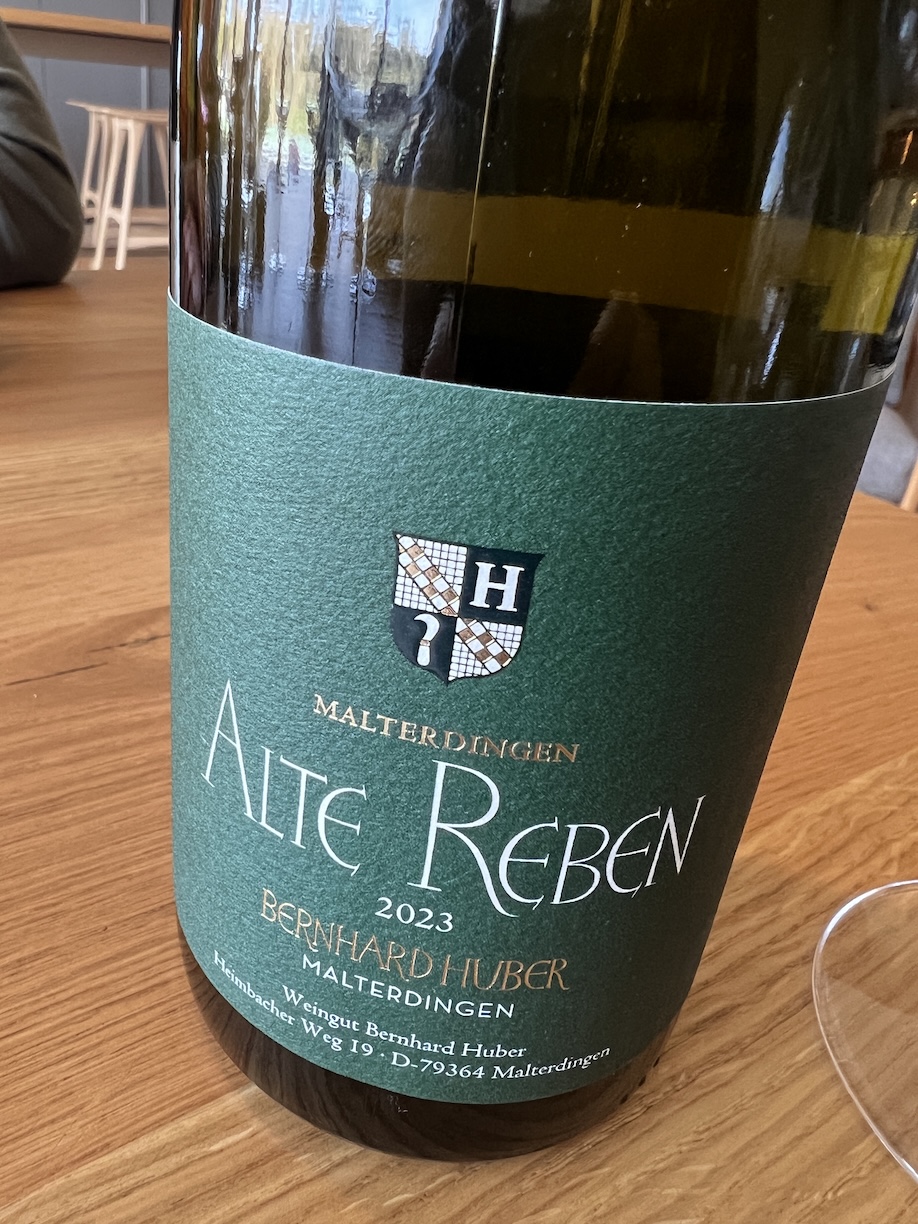
For optimal price/quality ratios, the Alte Reben (old vines) in both Chardonnay and Pinot Noir, is an excellent choice!
At the top, Bienenberg GG Chardonnay showed greater reduction and acidity, white florals and chamomile, while Schlossberg GG Chardonnay took everything (yet again) a step further: crystalline, herbal, intensely saline, with remarkable length and composure. These are wines built not for immediate charm but for evolution.
A brief aside worth noting: the Breisgau cuvée (50% Pinot Blanc, 50% Pinot Gris), now in its third vintage, displayed what sommeliers aptly call the “Huber nose”—reductive, precise, and disciplined. Pinot Gris is picked early to avoid heaviness, resulting in a taut, gastronomic white of real interest.
A World-Class Estate, Quietly So
This was not my first encounter with the Huber estate. I first visited Wildenstein in 2014, walking the limestone-over-clay slopes with Bernhard Huber himself, just months before his passing. As I wrote at the time, one cannot help but notice the rocky surface and pronounced incline of this extraordinary site—a place that feels closer to Burgundy than to most preconceived notions of German red wine. Bernhard reminded me then that it was Cistercian monks who first planted Pinot Noir here, centuries earlier, laying the foundations for what would become one of Germany’s most revered vineyards. Wildenstein, just two hectares in size, was already widely regarded as producing arguably the finest Pinot Noir in the country, irrespective of price.
Historical records dating back to 1285 attest to Pinot Noir plantings known as “Malterdinger”, named after the village that remains the heart of the estate today. The continuity is striking. The vineyards have been in the Huber family for generations, but it was Bernhard and his wife Barbara, upon taking over in 1987, who began estate bottling under their own name. Until then, grapes and wine had been sold to a local cooperative. That decision—to bottle, to define a style, to look to Burgundy not for imitation but for inspiration—changed the trajectory not only of the estate, but of German Pinot Noir more broadly.
That 2014 visit remains vivid in my memory. Bernhard was generous with his time, walking me through the vineyards and later insisting we sit down for lunch, to taste the wines in their proper setting, as he put it—at table, with food, and without haste. Returning now, a decade later, tasting through the range under Julian’s stewardship, the sense of continuity is unmistakable. The wines have evolved, sharpened, and gained tension, but the foundations laid by Bernhard with patience, humility before terroir, and an unshakeable belief in Pinot Noir, remain firmly intact.
Around 90% of Huber’s production remains in Germany, and it is hard to find! Most wines at the estate were already sold out. Some are exported, particularly to Scandinavia, a market that is growing steadily. Demand far exceeds supply, especially for the Chardonnays and GGs, yet the estate resists hype. What defines Huber today is not ambition for expansion, but an unwavering commitment to style.
As Julian Huber has said, wines here are not meant to impress instantly, but to reveal themselves over time. Tasting across the range in November, that philosophy felt not like dogma, but lived experience. These are wines of discipline, restraint, and inner confidence: Burgundian in method, unmistakably Baden in soul.
Few estates pursue their vision with such consistency. Even fewer succeed so completely.
What’s in a Name?
Posted on December 27, 2025

Why wine origin still matters
By Panos Kakaviatos for Wine Chronicles
27 December 2025
Every so often, the wine world is reminded that names are not neutral. They carry weight, memory, and meaning that must be defended.
Just before Christmas, Burgundy’s trade body, the Comité des Vins de Bourgogne, intervened after a major discount retailer aired a radio advertisement promoting a low-priced wine from the IGP Pays d’Oc. The advert praised the wine by evoking “this Burgundian grape with hazelnut aromas”, a formulation clearly designed to borrow the reputation of Burgundy while selling a wine with no geographical or cultural link to it. Within days, the campaign was withdrawn.
At first glance, this may seem like an overreaction. After all, Chardonnay is grown worldwide, right? From Napa to New Zealand, by way of Germany to South Africa. But Burgundy’s response was not about a grape name. It was about origin, precision, and the protection of a system that gives wine its meaning.
Take the bottle illustrated here: Chablis Grand Cru La Moutonne 2009, Domaine Long-Depaquit. Yes, it is Chardonnay — but that is only the beginning of the story. It is Chablis, a distinct appellation within Burgundy. More than that, it comes from a single, historic Grand Cru vineyard site, La Moutonne, uniquely positioned between Les Preuses and Vaudésir, and long recognised for its singular expression. Domaine Long-Depaquit, based in the heart of Chablis, farms some 65 hectares, including five Premier Crus and five Grand Crus, each with its own identity, exposure, soils, and voice.
This is what the appellation system exists to protect: not abstractions, but layers of specificity. Place within place. Within place! Climate, slope, geology, history, human interpretation. Burgundy is not Burgundy because it grows Chardonnay; it is Burgundy because Chardonnay grown there tastes like nowhere else.
When a mass-market wine uses Burgundy’s reputation as a convenient flavour cue, it flattens all of this complexity into a marketing shortcut. That is why the Burgundy Wine Council reacted so strongly. It was not out of arrogance, but out of necessity. Once meaning is diluted, it is difficult to restore.
The same logic applies beyond Burgundy. Champagne is not a synonym for sparkling wine. Porto is not a style descriptor. Barolo is not a generic red. These names are legally protected because they correspond to real places and collective histories. They also protect the consumer, who has every right to expect that a reference to a region implies more than a vague stylistic suggestion.
In an era when wine is increasingly marketed like any other fast-moving consumer good, the temptation to “borrow” prestige remains strong, especially at the lower end of the price spectrum. But prestige in wine is not decorative. It is cumulative and shared.
So yes, this was only a radio advertisement. But it serves as a useful reminder: in wine, names still matter. They matter because behind them lie vineyards like La Moutonne, and thousands of others, whose identity depends on respect for origin, without which wine becomes just another beverage.
What Is Politics?
Posted on December 26, 2025

Reading a friend’s book, thinking politically
Book review by Panos Kakaviatos
26 December 2025
There is a challenge to review a book edited by a friend, especially when that friend is a political scientist and one’s own professional life unfolds in a different, if adjacent, register.
Colin Hay and I have known each other for several years, tasting and reviewing wines in Bordeaux especially. But we both inhabit worlds that are political, though not in the same way. Colin approaches politics analytically, as a professor and theorist. I encounter it more obliquely, through media relations at the Council of Europe, and – perhaps unexpectedly – through wine writing, where questions of identity, power, tradition, and belonging are never far below the surface.
It is precisely this shared but differently practiced relationship to politics that makes What Is Politics? The Definitive Guide to Politics in Our Polarized Times such an interesting book to read from outside the academy, yet not outside politics.
Hay’s introduction sets out the intellectual ambition with characteristic clarity. Politics, he argues, is not reducible to what politicians do, nor exhausted by elections or institutions. It is a broader process of collective choice-making under conditions of contingency: conditions in which neither fate, tradition, nor technocratic management can plausibly absolve us of responsibility. This framing resonates beyond political science. Anyone who has watched cultural traditions defended, contested, rebranded, or instrumentalized (in gastronomy no less than geopolitics) will recognize the terrain.
The book’s structure reflects this expansive view. Each chapter approaches politics through a different analytical lens: power, moral choice, collective action, behaviour, identification, gender, cognition, ritual, rhetoric, crisis management. At times, the language is unapologetically technical. This is not a book that flattens political theory for ease of consumption. But its seriousness is also its virtue. It insists that how we conceptualizepolitics shapes what we expect from it, and what we excuse when it fails.
For me, the most compelling chapter is Vivienne Jabri’s “Politics as identification.” It is here that the book speaks most directly to the political moment we inhabit. Jabri explores how identities – national, ethnic, cultural, gendered – are not simply inherited facts but are produced, performed, and mobilized through practices of identification. Identity, in this sense, is not outside politics; it is one of its most powerful currencies.
What makes this chapter especially valuable is that it resists easy moral sorting. Identity politics is presented neither as progressive virtue nor as reactionary vice. It is shown instead as a political force that can enable recognition, solidarity, and resistance, but also exclusion, hierarchy, and simplification. The danger arises when identity hardens into destiny, when politics becomes a struggle over who is rather than what ought to be done.
Read this way, the chapter offers tools for understanding abuses of identity across the political spectrum. Progressive struggles for recognition can slide into moral absolutism; conservative or nationalist appeals to heritage can become civilizational dogma. In both cases, the move is the same: difference is essentialized, disagreement moralized, and politics reduced to a friend. That insight feels particularly urgent today.
Some readers may find the book’s conceptual vocabulary (gendered politics, performativity, institutionalized exclusion) more familiar or persuasive than others. The volume emerges from traditions of critical political analysis, and it does not pretend to ideological neutrality. But that, too, is part of its honesty. Like good wine writing, good political analysis is never written from nowhere. It reflects choices (of lens, emphasis, and framing) that deserve to be made visible rather than disguised.
Perhaps that is where my own reading converges with Colin’s project. Wine writing, at its best, is not just about flavour; it is about place, memory, power, legitimacy, and who gets to define value. Media relations at an institution like the Council of Europe is not simply communication; it is the careful navigation of language, identity, and representation in a crowded political space. In different ways, we are both engaged in what Hay describes as politics: making sense of collective choices under conditions of uncertainty.
What Is Politics? does not offer comfort, nor does it offer slogans. It offers something rarer: an invitation to think more carefully about the categories we use when we say something ispolitical, or insist that it is not. In polarized times, that invitation is not merely academic. It is political.
Just in time for the holidays: Dinner at Giscours
Posted on December 12, 2025

Biodiversity contributes to Margaux Renaissance
By Panos Kakaviatos for Wine Chronicles
12 December 2025
It had just rained when I arrived at Château Giscours – the eve of my birthday on 5 December this year. Under a veil of evening mist, the estate had fallen into contemplative quiet. As my car that early evening rolled down the long approach off the main D2 road that lines the famous châteaux of the Médoc, the first beings to welcome me were not employees. It was not the grand silhouette of the château itself. But a flock of Landes ewes, grazing peacefully in the semi-darkness. They lifted their heads with mild curiosity, as if to signal that at Giscours, the land speaks first.

Morning after dinner: Some sixty Landes ewes, together with their lambs, maintain the park and meadows at Château Giscours as the seasons change.
This encounter was as charming as it was symbolic. Giscours is one of the rare Bordeaux estates where agricultural life has marked a return as integral to identity. The ewes – along with Bordelais cattle, goats, ducks, geese, and hens—form part of an eco-pastoral system that maintains more than 150 hectares of meadows, forest and parkland. The estate collaborates with the Conservatoire des Races d’Aquitaine to preserve endangered local breeds. Biodiversity here is not merely marketing; it has become part of the château’s identity.

The Château Giscours Margaux, tasted three times since bottling, is excellent in 2023, but even the estate’s Haut-Médoc, above, is fine. Some 60 hectares under vine are used for the Haut-Médoc.
But beyond that, the wines at Giscours have improved in quality. Markedly. I recall an old friend of my father’s, an avid Bordeaux buyer, back in the late 1990s. He said that “it is a waste of time to buy wines like Giscours when you can purchase Palmer,” referring to the superlative (also officially Third Growth in the 1855 Classification of Médoc wines) of Château Palmer. Admittedly, Château Giscours dipped in quality from the mid-1980s and 1990s, with a low price to be sure compared to Palmer, but Palmer was not as expensive back in the late 1990s as it became in the 21st century.
While Château Palmer deserves a promotion in a theoretical revamping of the 1855 Classification, the perception of Château Giscours as a clearly inferior wine no longer holds. Indeed, Château Giscours now reflects a cream of the Third Growth crop (Note to readers, I have an article coming up next year in Decanter Magazine comparing all of the Third Growths).
Indeed, over the past two decades, and especially in recent years, the work carried out under the steady hand of Alexander Van Beek, director since 1998, has fundamentally improved the wines of Giscours. This transformation has not come through flashy shortcuts, but through attention to detail: vineyard restructuring, parcel-by-parcel vinification, precision harvesting, gentler extractions, and a clearer vision of balance over power. And attention to personnel.
Take the relatively recent hire (January 2021) of the young, but already experienced Jérôme Poisson, 43 years old. Poisson mirrors Van Beek’s focus on detail combined with his vineyard and vinification work across the world, from Chile and the United States, to Alsace, Italy and – since 2021 – Bordeaux. He has contributed to the steady climb in the wine’s consistency, definition, and elegance. That is to say, wines that now marry Margaux perfume with substance and longevity.

Château Giscours director Alexander Van Beek, right, at a tasting in New York, January 2023, with Bordeaux negociant Ivanhoe Johnston
This trajectory reached a symbolic milestone this year when Château Giscours 2022 was named Wine of the Year by Wine Spectator—a recognition that would have been less likely a generation ago. Today, Giscours no longer invites comparisons as a lesser alternative to its neighbors; it stands confidently on its own, a château that has rediscovered both its ambition and its place.
A bit of history
We can go back the future to explain why the recent emphasis on biodiversity is part of the plan not only to make the wine better, but also to accentuate the proud history of the estate, which traces its roots to 1552, when Bordeaux draper Pierre de Lhomme established the first vineyards. Over the centuries, owners such as Jean-Pierre Pescatore and Édouard Cruse transformed the château into a neoclassical palace, modernized winemaking, and commissioned the magnificent park designed by Eugène Bühler, a master landscaper from Versailles.
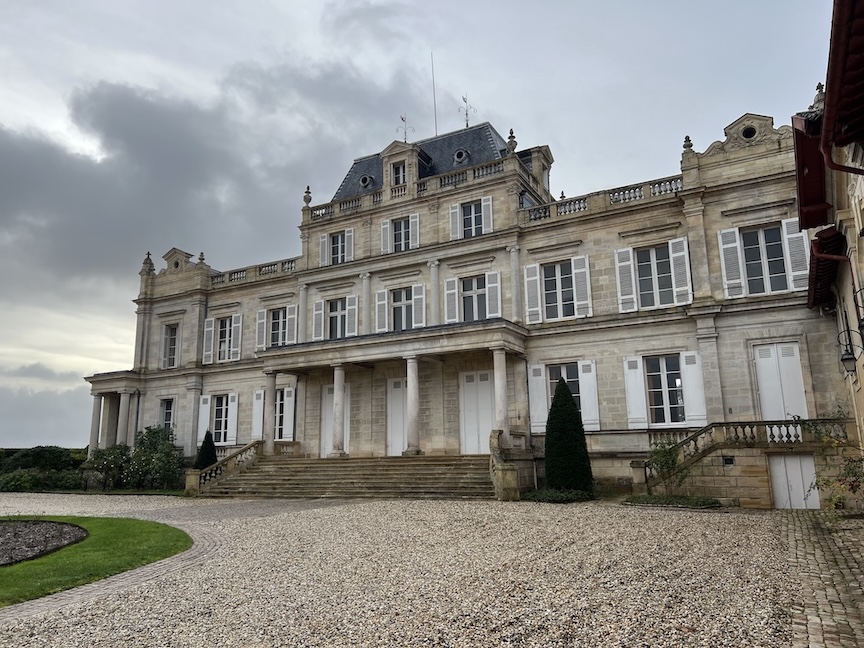
A gorgeous estate
Under the leadership of the Albada Jelgersma family, Giscours today continues its tradition of reinvention. The vegetable garden – tended daily by Ahmed Jaayjaa – supplies the château kitchen with seasonal produce. The herd maintains the fields. And in the cellar, a technical team oversees winemaking that blends precision with gentleness: optical sorting, cold macerations, intra-plot harvesting, and interplanting of old vines (some dating back to 1923). No less than 21 workers and their families live year-round on the estate, lending a sense of home to the place.
Magnificent holiday dinner
Stepping into the château that evening felt like entering a sumptuous holiday refuge. A tall Christmas tree stood beside long windows framed by golden curtains. Candles flickered at the edges of the room; historical paintings dominating the walls. The décor – warm, intimate, refined – reflected a philosophy of hospitality blending elegance with ease.
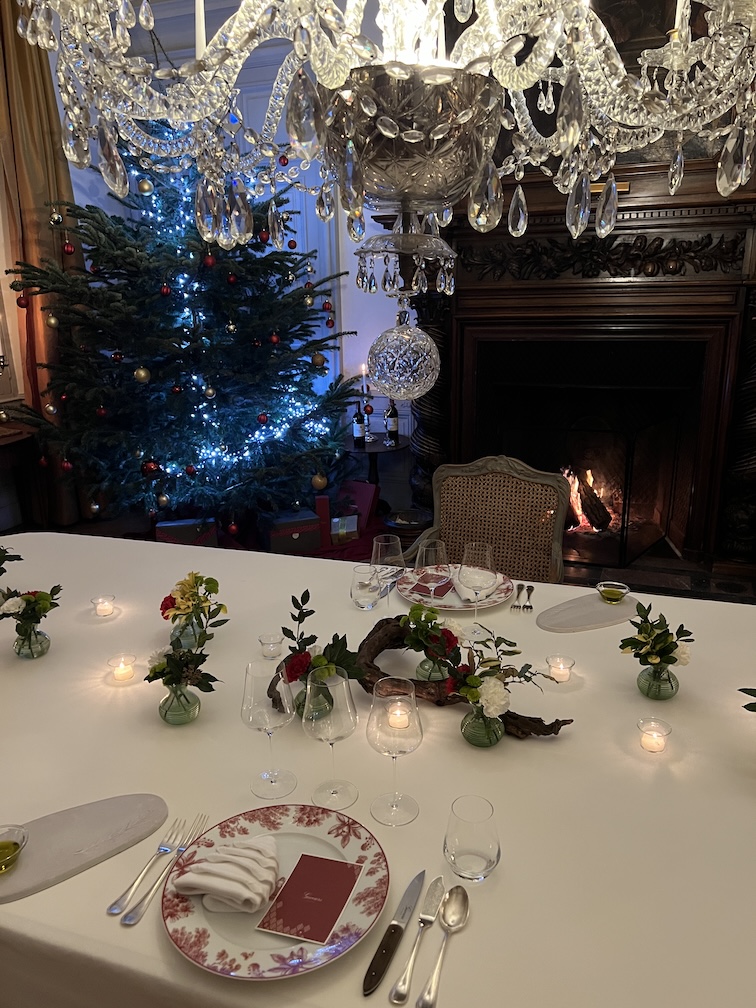
Fireside holiday dinner at Château Giscours
A table was set with red-and-white botanical porcelain. At its center lay the printed menu for Dîner du vendredi 5 décembre 2025. By the time dinner ended, I photographed my two hosts standing by the fireplace: Poisson on one side, and estate chef Benjamin Laurent on the other, wearing the château apron. The fire behind them cast a soft glow on the carved wood mantel, creating a tableau that could have belonged to another century.
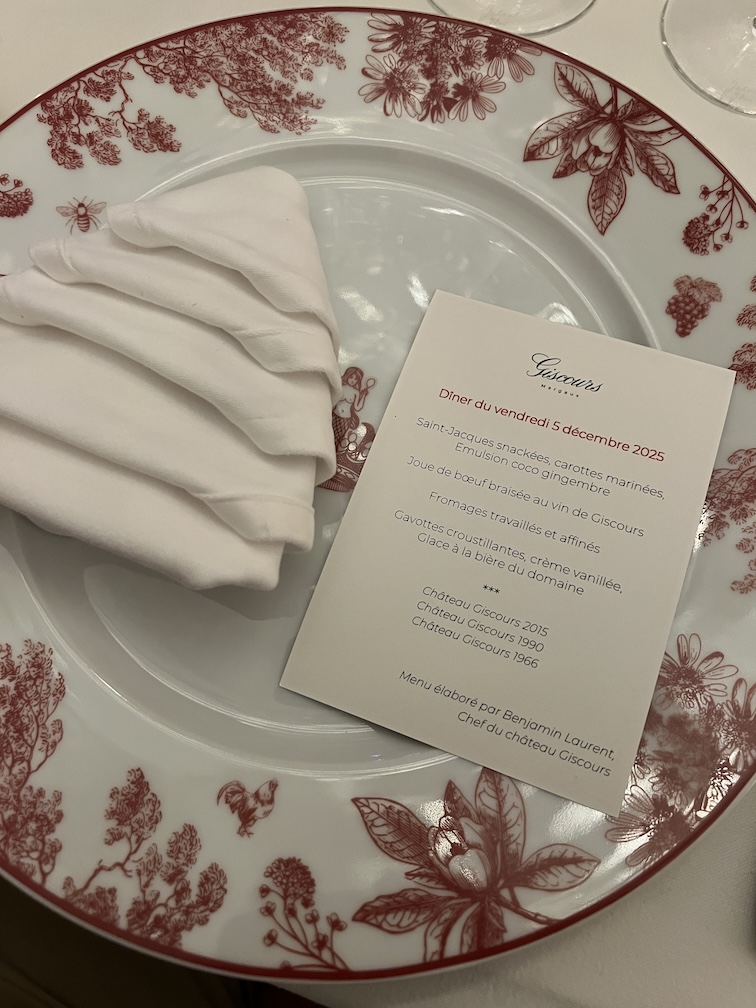
Attention to detail, the pristine table linen shaped as a Christmas tree.
Chef Laurent, who arrived at Giscours in 2019 after formative years with Michel Guérard at the amazing Les Prés d’Eugénie and as a pastry chef at the Hôtel de Crillon in Paris, prepared a meal that was a celebration of winter and of Giscours’s agricultural identity.

Chef Benjamin Laurent with estate manager Jérôme Poisson
He opened with an unexpected, deeply comforting dish that looked like a fine cappuccino but was chestnut broth, enriched with chopped chestnuts, foie gras, and a hint of Armagnac. Its aromas instantly set the tone: rich yet airy, nostalgic yet precise.
The next course showcased Laurent’s technical finesse: seared scallops whose caramelized crusts contrasted beautifully with carrots and grilled hazelnuts in an umami like sauce capped with delicate ginger-coconut emulsion that added lift. “I like having flavors that at once confront one another but also work together,” Laurent remarked after the meal. It worked.
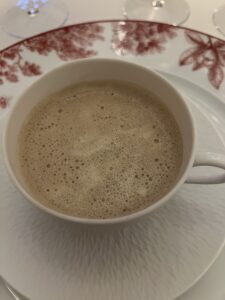
No, that’s not cappuccino.
But it was the main dish – classic braised beef cheek in a Giscours wine sauce accompanied by silky potato purée – that best paired the Giscours wines that were served. It was a dish of depth, winter comfort, and classical balance.
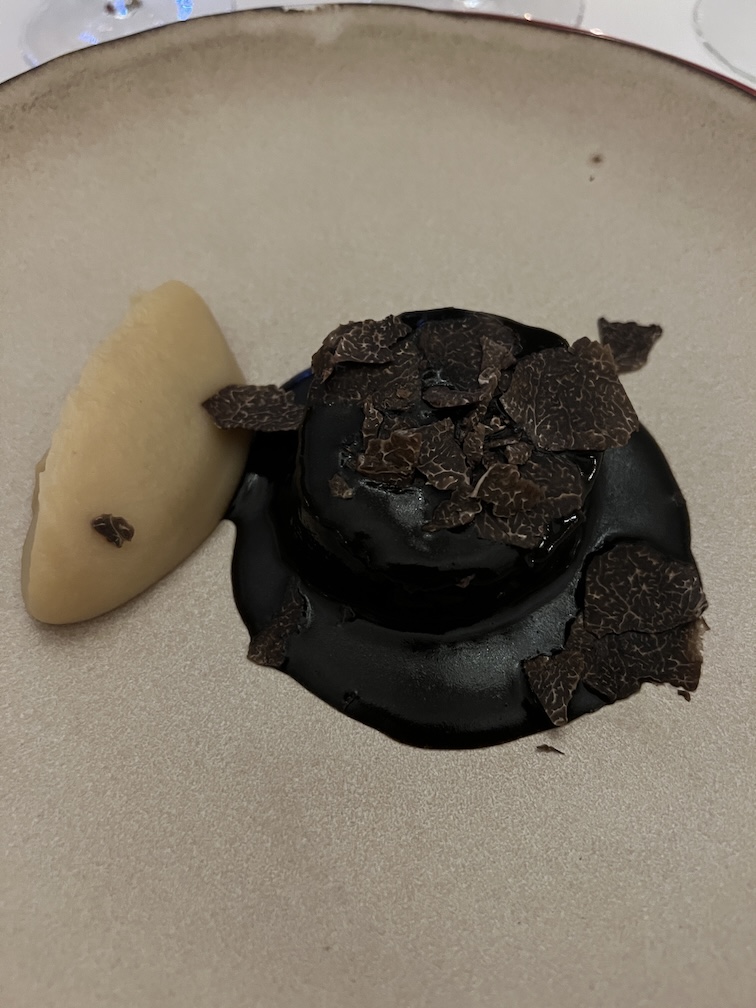
And that is not chocolate 🙂
And for the oldest Giscours, the 1966, I especially enjoyed the Brillat-Savarin with truffle in the cheese course, which included Vieux Gouda and fresh Chèvre de Touraine.
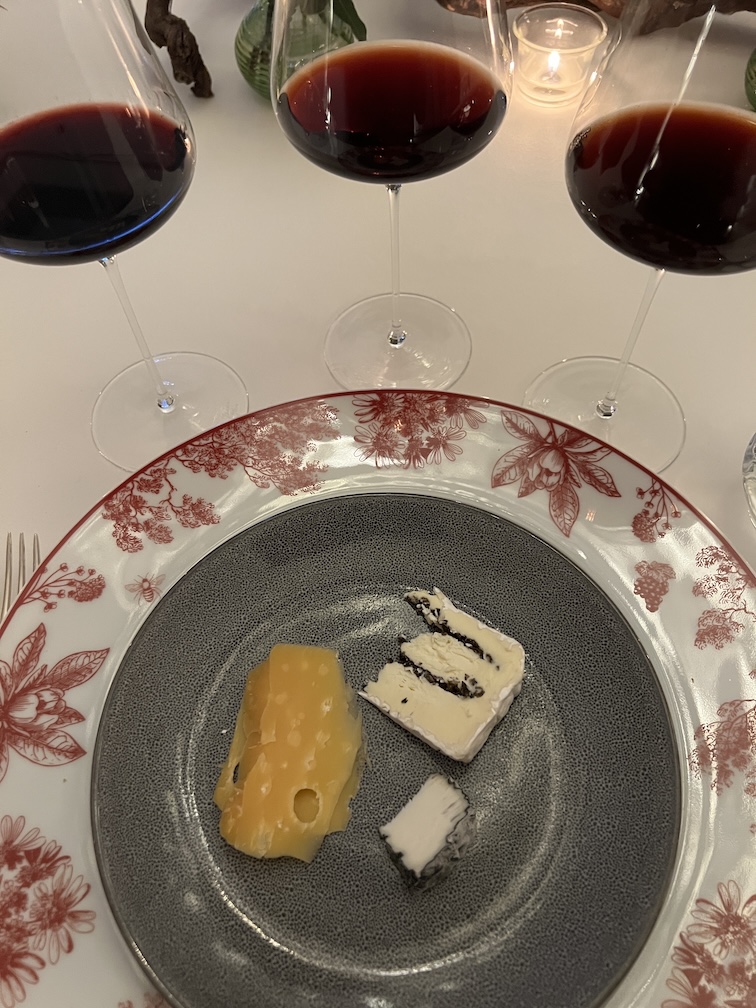
Cheese trio
The dessert delivered a playful surprise: crispy gavottes with vanilla cream and house-made beer ice cream, a nod to the chef’s pastry roots and the estate’s spirit of innovation.
Accompanying the meal were three vintages that illustrated the estate’s evolution across nearly fifty years: Check out my Instagram reel on this dinner!

Brillant Margaux vintage, also excellent at Château Giscours
2015
A wine shimmering with a decade of youth, considered to be a great vintage for the Margaux appellation. Today, an adolescent with class, powerful yet polished, marked by suave tannins and a long, resonant finish. Still climbing toward its peak. Price on Wine-Searcher.
1990
More delicate, a touch thinned with age, the fruit softened. An instructive contrast rather than a standout, and perhaps the bottle/cork was not optimal.

Birthday vintage
1966
The revelation of the evening. The aromatics unfurled with breathtaking vitality: truffle, forest floor, powdered cocoa, musk, all rising from the glass with coherence and grace. On the palate, it began firm, then opened gradually, becoming medium-bodied, expressive, and flavorful. A dryness on the finish, yet the wine remained vibrant, very much alive. Seeing the 1966 beside its decanter, the candlelight catching the garnet hue, felt like a communion with Bordeaux’s past.
Highs and lows
It is all about heights and valleys. In my many years visiting the Bordeaux region, I recall what Anthony Barton had told me back in 2002, when I was at Langoa Barton: each château has had its ups and downs. “In the 1920s for example, Léoville Poyferré was especially celebrated,” Barton said, “while we were not as well assessed.” Giscours may have had a bit of a valley from the mid-1980s to the 1990s, but the 1960s and 1970s proved superb. I still recall the 1970, a superlative wine drinking well still today, with a smoother palate than the 1966 for example.
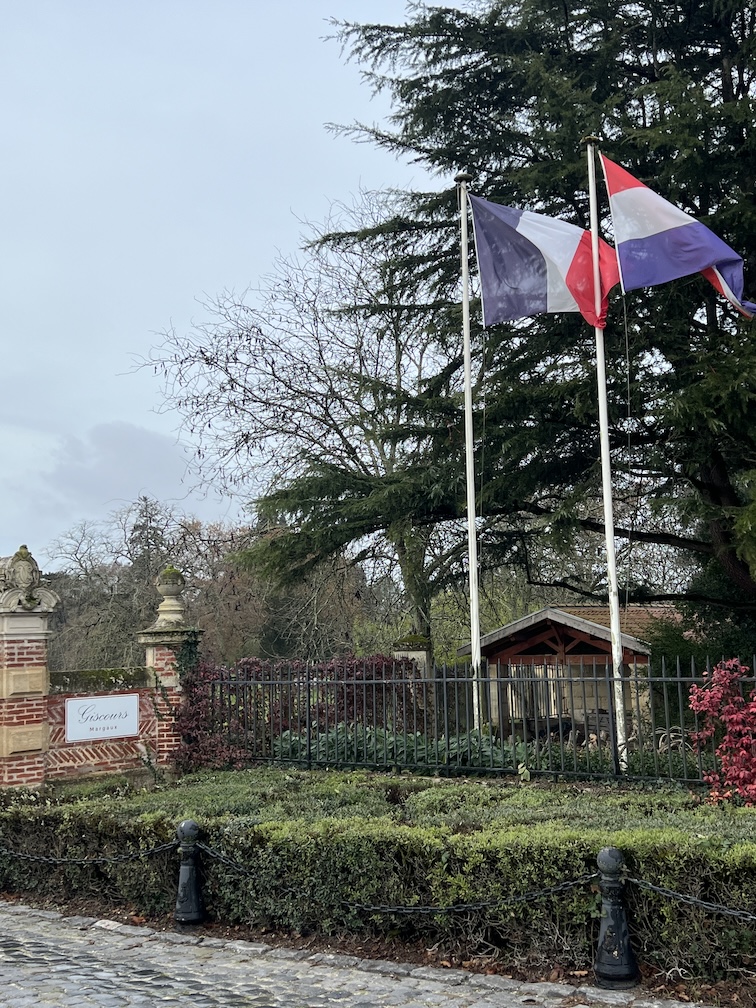
Flags of France and the Netherlands, reflecting Dutch ownership
I woke on my birthday to a quiet, misty estate. The ewes were grazing, a bit further from the château, as seen in the photo at the beginning of this text. I took a 20 minute walk, enjoying the fresh, pre-winter air. The night before had been more than a stay; it had been an immersion in a landscape shaped by centuries of human ambition and agricultural rhythm. Giscours is not frozen in time; it is alive, renewing itself with each season, each generation, each vintage. And savvy wine lovers should buy the wines. Before the dinner, I was impressed by the quality of the 2023 (Wine-Searcher price), a worthy follow up to the 2022 (Wine-Searcher price): despite recent tax increases, both affordable for the quality.
And one great way to find your favorite wines? Check out Capital One Shopping’s One Stop Wine Shop!
Bordeaux : Welcome 2023
Posted on November 30, 2025

Initial reflections on Bordeaux 2023 – from Zürich to Bellefont-Belcier
By Panos Kakaviatos for Wine Chronicles
30 November 2025
After a comprehensive tasting organised by the Union des Grands Crus de Bordeaux (UGCB) of the recently bottled 2023 vintage in Zürich earlier this month, I left less impressed than expected. One often hears winemakers praise 2023 as a “return to classicism” – fresher, more terroir-centered, a welcome alternative to the sometimes (over) voluminous 2022s. I arrived in Zürich expecting that clarity to shine. Instead, while the wines were certainly good, but few struck me as ground-breaking. You will read about those wines in a later post, when I revamp my website to a subscriber format. In any case, the narrative of vibrant, terroir-driven purity did not consistently play out in the glass.
This stood in contrast to the anticipation I had built earlier this autumn. Having tasted about 250 bottles of 2022 from bottle, I had already noted that many of the en primeur highs were proving somewhat moChâtnolithic, reflecting more the sun than the soils. And that 2023 might well be the safer haven for readers who prize cooler balance and energy. Several winemakers privately express a preference for the 2023s for these reasons — and I share that view. To some extent, as Zürich did not fully confirm it.
But then came last night at Château Bellefont-Belcier in Saint-Emilion.
Tasting the full Vignobles K lineup with co-owner Howard Kwok and winemaking director Jean-Christophe Meyrou – photo above – restored my confidence in the best that 2023 can offer. Meyrou reminded us that 2023 was challenging: intense mildew pressure from April to Véraison (the summer phase when grapes begin to soften and change colour) required speed and vigilance.
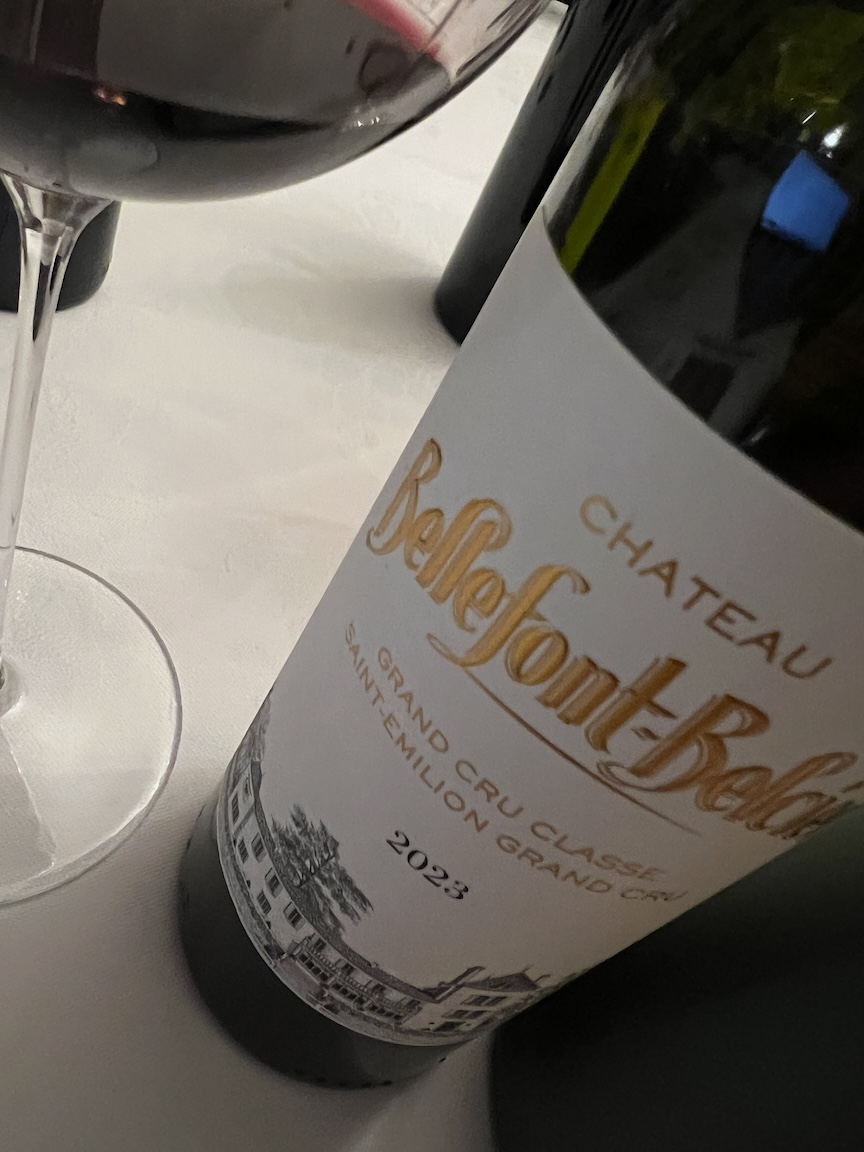
Superlative Bellefont-Belcier
“We had the team ready to go,” Meyrou said. Yields ended just around 40 hl/ha — correct for their objectives — and they continue to reduce sulfite use, reserving additions mainly for bottling to help integrate oak. Crucially, Meyrou believes that 2022 sometimes dominates terroir, whereas 2023 expresses it. I agree. Bellefont-Belcier illustrates this particularly well.
Since 2017–18, the style at Bellefont-Belcier has changed dramatically for the better: precision over weight, finesse over flash. The 2023 confirms this trajectory. It shows a classy aromatic profile and a wonderfully tactile palate — that rare sensation of “feeling the skin of the grape” without any heaviness. The texture is superbly refined, the balance effortless, despite 14.5% alcohol. It was my favorite of the entire lineup.
Other highlights included the sculpted and delicate Enclos de Viaud (Lalande de Pomerol, at a bargain of around $20), the structured and appealing Château La Patache, in Pomerol, and the powerful, ageworthy Tourmaline also in Pomerol. In Saint-Émilion, Tour Saint Christophe impressed yet again with its combination of power and polish, reminding us of the still recent, well-deserved promotion to Grand Cru Classé, while Haut Brisson showed nuance and energy, if a touch austere.
This tasting reminded me of something important: while broad UGCB tastings give us a map, focused visits like this offer altitude and topography. At Bellefont-Belcier, the classical virtues of 2023 — clarity, balance, terroir — were not theoretical; they were palpable.
And the story is far from over.
This coming week, I’ll be back in Bordeaux to taste hundreds of additional 2023s. It will be a crucial opportunity to see the full landscape of the vintage, to confirm whether Zürich was an outlier — and whether estates like Bellefont-Belcier point toward a broader truth about 2023’s balance, freshness, and potential. Stay tuned: the picture may sharpen considerably in the days ahead. Also, please stay tuned for a revamped subscriber based website, where you will get over 25 years of experience in my tasting wines, particularly the wines of Bordeaux.
 Wine Chronicles
Wine Chronicles
Recent Comments